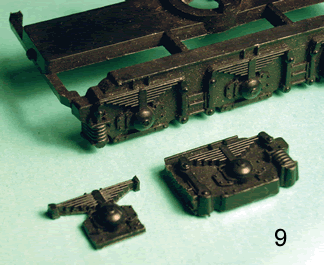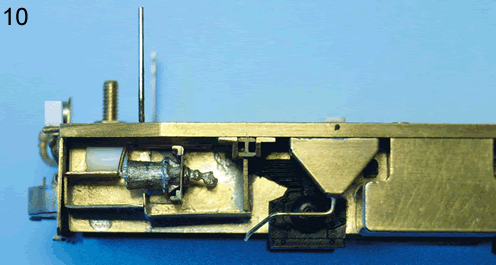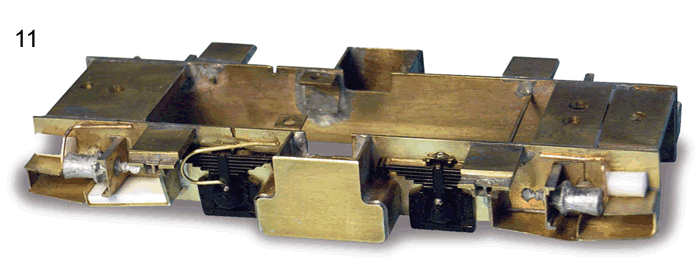

 |
 |
|
available cast whitemetal parts (in fact they were intended for a New South Wales 422 class diesel). The stiffener plate which connects the bottom step to the web under the lifting point was made from 0.15mm brass. Soldering these tiny parts became quite a challenge, but I got acceptable results by first applying a small dab of solder with an iron, then hitting it with a very brief blast from a small gas torch to run the solder into a neat fillet without providing sufficient heat to unsolder the surroundings. It was important to ensure all the soldering was completed before moving on to adding plastic components. Axleboxes and springs I removed the axlebox and springs from the bogie frame by first cutting off the section of frame that carried them, then sanding away the back of the frame until only about 0.3mm thickness remained. Then the axlebox and spring was removed as a single piece by carefully cutting around it with a craft knife (with a fresh blade). This was then fastened to the frame with superglue. I hesitated for some time before |
fitting them, as the lack of visibility of the springs in photos, plus their absence on some drawings, made me wonder if the locos did in fact have leaf springs. However, enquiries to other modellers, and some searching on the internet, confirmed the arrangement of the leaf springs. Detailing Several other details were added to the chassis using styrene or wire. A styrene cab floor and crew seat was added to the footplate, to facilitate the fitting of crew figures later. Also the body kit does not include the filler caps for the front sandbox, so these were added to the footplate using a small circle of thin styrene. Presumably on the prototype the filler for the rear sandbox is accessible within the casing that extends forward from the cab. The speedometer cable from the right-hand rear axlebox was formed from 0.15mm brass wire. Photos of the locos indicate that there is a small cylinder located inboard from |
9. To save
work, the four axleboxes and springs were cut from a plastic bogie (from a Lima hot metal wagon).While not exactly correct, they are close, and barely visible on the finished model. 10. The end of the frame, showing the brake cylinders and axleboxes fitted (with the footplate in situ to check clearance of the lifting points and sandboxes). |
 |
11. The completed chassis, with some details added in plastic. The wire from the rear axlebox (only on the right-hand side of the loco) is the speedometer cable, though in service the NDM6s are not called upon to run at much above 40km/h. |
|
| December 2010 | 803 | |
| Next Page | ||
|
||